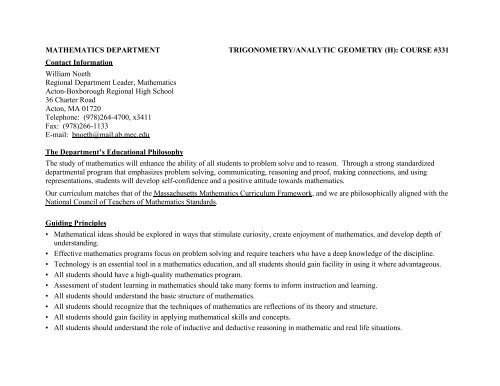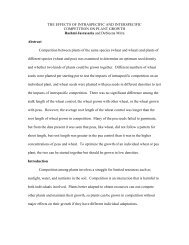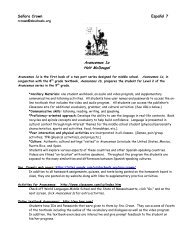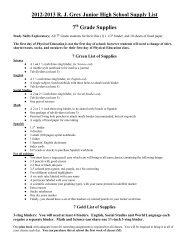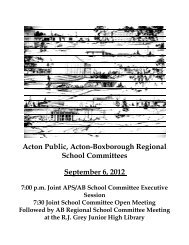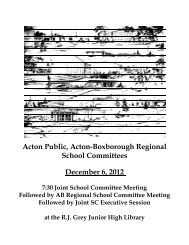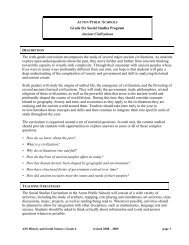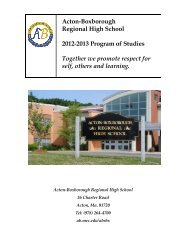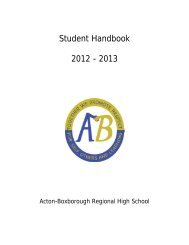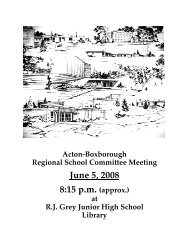H - Acton-Boxborough Regional School District - MEC
H - Acton-Boxborough Regional School District - MEC
H - Acton-Boxborough Regional School District - MEC
Create successful ePaper yourself
Turn your PDF publications into a flip-book with our unique Google optimized e-Paper software.
MATHEMATICS DEPARTMENT TRIGONOMETRY/ANALYTIC GEOMETRY (H): COURSE #331<br />
Contact Information<br />
William Noeth<br />
<strong>Regional</strong> Department Leader, Mathematics<br />
<strong>Acton</strong>-<strong>Boxborough</strong> <strong>Regional</strong> High <strong>School</strong><br />
36 Charter Road<br />
<strong>Acton</strong>, MA 01720<br />
Telephone: (978)264-4700, x3411<br />
Fax: (978)266-1133<br />
E-mail: bnoeth@mail.ab.mec.edu<br />
The Department’s Educational Philosophy<br />
The study of mathematics will enhance the ability of all students to problem solve and to reason. Through a strong standardized<br />
departmental program that emphasizes problem solving, communicating, reasoning and proof, making connections, and using<br />
representations, students will develop self-confidence and a positive attitude towards mathematics.<br />
Our curriculum matches that of the Massachusetts Mathematics Curriculum Framework, and we are philosophically aligned with the<br />
National Council of Teachers of Mathematics Standards.<br />
Guiding Principles<br />
• Mathematical ideas should be explored in ways that stimulate curiosity, create enjoyment of mathematics, and develop depth of<br />
understanding.<br />
• Effective mathematics programs focus on problem solving and require teachers who have a deep knowledge of the discipline.<br />
• Technology is an essential tool in a mathematics education, and all students should gain facility in using it where advantageous.<br />
• All students should have a high-quality mathematics program.<br />
• Assessment of student learning in mathematics should take many forms to inform instruction and learning.<br />
• All students should understand the basic structure of mathematics.<br />
• All students should recognize that the techniques of mathematics are reflections of its theory and structure.<br />
• All students should gain facility in applying mathematical skills and concepts.<br />
• All students should understand the role of inductive and deductive reasoning in mathematic and real life situations.
TRIGONOMETRY/ANALYTIC GEOMETRY (H): COURSE #331<br />
Course Frequency: Full-year course; five times per week<br />
Credits Offered: Five<br />
Prerequisites: A final grade of at least 80 in Algebra II Honors or 90 in Algebra II AE<br />
Background to the Curriculum<br />
This course uses the McDougal Littell text Advanced Mathematics – Precalculus with Discrete Mathematics and Data Analysis,<br />
Brown, 2000 edition. It is the “Precalculus” course, which fits between the Algebra II program and one of the Advanced Placement<br />
Calculus classes. This text has been used since 1993; it replaced the text Advanced Mathematics by Coxford, published by Harcourt<br />
Brace Jovanovich, which had been used since 1980. The text is followed quite closely, and all material is covered except for the Data<br />
Analysis material. The text matches the 2000 edition of the Massachusetts State Frameworks for a Precalculus course and is<br />
philosophically aligned with the spirit of the National Council of Teachers of Mathematics Curriculum Standards. Teachers bring in<br />
other material where appropriate or time permits after consultation with the <strong>Regional</strong> Department Leader.<br />
Core Topics / Questions / Concepts/ Skills<br />
Linear, Quadratic, Polynomial Functions<br />
The General Theory of Functions<br />
Trigonometric Functions and Their Inverses<br />
Graphing Theory for Trigonometric Functions<br />
Trigonometric Identities – Pythagorean, Sums, Difference, Double Angle, Half Angle<br />
Polar Coordinates for Points and Complex Numbers<br />
Vectors in Two Space and Three Space<br />
Parametric Equations<br />
Matrices in Equation Solving and Transformations<br />
Limit Theory<br />
Derivatives of Polynomials and Other Simple Functions<br />
Applications of Derivatives<br />
Exponential and Logarithmic Functions<br />
Analytic Geometry of the Conic Sections<br />
ABRHS (Trig/Analytic Geometry H: Course #331) 2004-2005 page 2
Course-End Learning Objectives<br />
Learning objectives<br />
1] find the equation of a linear function, given various<br />
information<br />
2] find the equation of a quadratic function, given various<br />
information<br />
3] model real-world situations by linear or quadratic functions<br />
4] use formulae for the distance between points and the distance<br />
from a point to a line<br />
5] sketch linear and quadratic functions, given various<br />
information<br />
6] use the Remainder and Factor Theorem<br />
7] graph polynomial functions and determine an equation for a<br />
polynomial graph<br />
8] write polynomial function for a given situation and find its<br />
maximum and/or minimum values<br />
9] use technology to approximate the real roots of a polynomial<br />
equation<br />
10] solve polynomial equations by various methods, including<br />
the Rational Root Theorem<br />
11] apply general theorems about polynomial equations<br />
12] solve linear, quadratic, and polynomial inequalities,<br />
including those with variable denominators<br />
13] solve certain applied problems using linear programming<br />
14] determine domain, range, zeroes of a function, and graph it<br />
15] perform the composition and inverse of functions<br />
16] determine periodicity and amplitude from graphs, stretch and<br />
shrink graphs vertically and horizontally, and translate them<br />
17] find the measure of an angle in degrees or radians<br />
18] find arc length and sector area in a circle<br />
19] use the definitions of cosine and sine in terms of x, y, r<br />
20] find values of trig functions using the definitions, reference<br />
arcs, special angles, and a calculator<br />
Corresponding state standards, where applicable<br />
Algebra/Analytic Geometry.P.6<br />
Algebra II.P.7<br />
Algebra I.P.11<br />
Geometry.G.12<br />
Algebra II.P.6<br />
Precalculus.P.2<br />
Precalculus.P.2<br />
Algebra II.P.12<br />
Algebra II.P.8<br />
Precalculus.P.2<br />
Precalculus.P.2<br />
Algebra II.P.8<br />
Algebra II.P.8<br />
Algebra II.P.6<br />
Algebra II.P.5<br />
Algebra II.P.13<br />
Precalculus.M.1<br />
Precalculus.M.1<br />
Algebra II.G.1<br />
Precalculus.P.3<br />
ABRHS (Trig/Analytic Geometry H: Course #331) 2004-2005 page 3
21] find values of the tangent, cotangent, secant, and cosecant<br />
functions<br />
22] find values of the inverse trig functions<br />
23] graph the basic trig functions using concepts of domain and<br />
range<br />
24] solve simple trig equations<br />
25] find equations of sine and cosine curves that model periodic<br />
behavior<br />
26] simplify trig expressions and prove trig identities<br />
27] use trig identities or technology to solve more difficult trig<br />
equations<br />
28] use right triangle trig, the Law of Sines, and the Law of<br />
Cosines to find unknown sides or angles of triangles<br />
29] find areas of triangles using Trigonometry<br />
30] derive and use identities for cosine, sine, and tangent<br />
involving sums, differences, double angles, and half angles<br />
31] solve trig inequalities using identities or technology<br />
32] use a variety of trig identities to simplify expressions and<br />
solve equations involving inverse trig functions<br />
33] convert polar points and equations to Cartesian points and<br />
equations, and vice versa<br />
34] graph the classical polar equations<br />
35] convert complex numbers to polar form and use DeMoivre’s<br />
Theorem<br />
36] perform basic operations on vectors in 2 space and 3 space<br />
37] use coordinates to perform vector operations in 2 space and 3<br />
space<br />
38] find norm and direction angle of a vector in 2 space<br />
39] use vector and parametric equations to describe motion in the<br />
plane and in space<br />
40] define and apply the dot product in 2 space and 3 space<br />
41] use determinants to solve algebraic and geometric problems<br />
42] define and apply the cross product of vectors in 3 space<br />
43] find the equation of a plane<br />
Precalculus.P.3<br />
Precalculus.P.3<br />
Precalculus.P.6<br />
Precalculus.P.5<br />
Precalculus.P.6<br />
Precalculus.P.5<br />
Precalculus.P.5<br />
Precalculus.G.1<br />
Precalculus.G.1<br />
Precalculus.P.5<br />
Precalculus.P.5<br />
Precalculus.P.5<br />
Precalculus.N.1<br />
Precalculus.N.1<br />
Precalculus.N.1<br />
Precalculus.G.2<br />
Precalculus.G.2<br />
precalculus.G.2<br />
Precalculus.G.2<br />
Precalculus.G.2<br />
Precalculus.G.2<br />
Precalculus.G.2<br />
Precalculus.G.2<br />
ABRHS (Trig/Analytic Geometry H: Course #331) 2004-2005 page 4
44] use sequences defined by general term or recursively<br />
45] use arithmetic and geometric sequences and series<br />
46] find or estimate the limit of an infinite sequence<br />
47] find the sum of an infinite series<br />
48] write proofs using the Principle of Mathematical Induction<br />
49] find the sum, difference, product of matrices<br />
50] find the inverse of matrices and solve linear systems using<br />
matrices<br />
51] use technology to solve systems of equations using matrices<br />
and their inverses<br />
52] find the images of sets of points under different types of<br />
transformations using matrices<br />
53] use integral and rational exponents<br />
54] use general exponential functions and the natural exponential<br />
function<br />
55] define and apply logarithms and use log laws<br />
56] solve exponential equations, and change logarithms from one<br />
base to another<br />
57] understand the relationship between logarithmic and<br />
exponential functions<br />
58] find the limit of a function as x ∞,x -∞x a<br />
59] determine whether a function is continuous at a point<br />
60] graph discontinuous functions<br />
61] understand the intuitive concepts of limits of functions<br />
62] graph rational and algebraic functions, including holes and<br />
asymptotes<br />
63] find derivatives of functions by definition<br />
64] find the derivative of a polynomial type function mentally<br />
and use it to find tangent line equations<br />
65] sketch the graphs of functions using derivatives<br />
66] solve maximum/minimum word problems using calculus<br />
67] find instantaneous velocity and acceleration<br />
68] prove theorems from geometry by using coordinates<br />
Algebra II.P.1<br />
Algebra II.P.2<br />
Algebra II.P.2<br />
Algebra II.P.2<br />
Precalculus.P.1<br />
Algebra II.P.9<br />
Algebra II.P.9<br />
Algebra II.P.9<br />
Geometry.G.15<br />
Algebra II.N.2<br />
Algebra II.P.4<br />
Algebra II.P.10<br />
Algebra II.P.10<br />
Algebra II.P.4<br />
Precalculus.P.9<br />
Precalculus.P.9<br />
Precalculus.P.9<br />
Precalculus.P.9<br />
Precalculus.P.9<br />
Precalculus.P.9<br />
Precalculus.P.9<br />
Precalculus.P.9<br />
Precalculus.P.9<br />
Precalculus.P.9<br />
Geometry.G.3<br />
ABRHS (Trig/Analytic Geometry H: Course #331) 2004-2005 page 5
69] find the equations of conic sections given geometric<br />
information<br />
70] graph conic sections with center at (h,k)<br />
71] solve systems of second degree equations<br />
72] compute the eccentricity and latus vectum of conic sections<br />
73] state and explain the equation for the general quadratic<br />
relation<br />
74] graph rotated conic sections by using technology<br />
75] graph rotated conic sections by eliminating the “xy term”<br />
Assessment<br />
Precalculus.P.8<br />
Precalculus.P.8<br />
Precalculus.P.8<br />
Pecalculus.P.8<br />
Precalculus.P.8<br />
Precalculus.P.8<br />
Precalculus.P.8<br />
Students are generally assessed by in-class tests and occasional quizzes, which are administered regularly throughout a marking<br />
period. The students’ attitude, effort, and quality of homework preparation will also impact their term grade to a small degree.<br />
Teachers informally assess students every day by asking pivotal questions, as well as questions involving mechanics or concepts, and<br />
the students’ term grades may be positively affected to a small degree based on their responses.<br />
A standardized midyear examination and final examination are administered to all students in this course in order to assess their longterm<br />
retention of the course material.<br />
Technology and Health Learning Objectives Addressed in This Course<br />
(This section is for faculty and administrative reference; students and parents may disregard.)<br />
Course activity: skills &/or topics taught<br />
Standard(s) addressed through this activity<br />
1] Graphing calculators are integrated throughout to find<br />
extreme values of functions<br />
2] Graphing calculators are used in the Trigonometry portion to<br />
fit data to sinusoids<br />
3] Graphing calculators are used to aid in Matrix computations<br />
4] Precalculus Plotter Plus software is used where feasible<br />
Materials and Resources<br />
Teachers use other texts for supplementary ideas, such as the Harcourt Brace Jovanovich text used previously and the text Precalculus<br />
– A Graphing Approach by Demara and Waits. Review materials that match both departmental examinations are used by all teachers<br />
of the course. Some teachers may employ the software package “Precalculus Plotter Plus” in the Mac Lab.<br />
ABRHS (Trig/Analytic Geometry H: Course #331) 2004-2005 page 6


